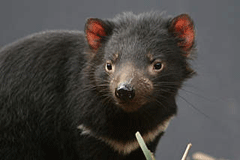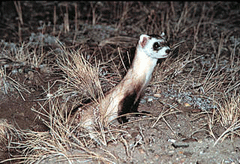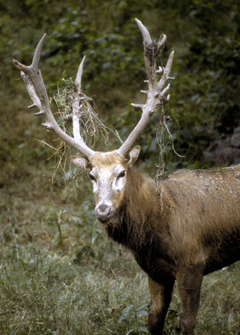Endangered Mammals
Air Date: Week of October 10, 2008

Tasmanian devil. Threat category: endangered. (Photo: David Hewett)
Twenty five percent of the worldÂ’s mammals are in danger of extinction. ThatÂ’s according to the Red List published by the International Union for Conservation of Nature. Mike Hoffmann, one of the authors of the study, speaks with host Bruce Gellerman about the list that brings together research from 1700 scientists on 5,500 species.
Transcript
GELLERMAN: Mammals are warm-blooded animals that have backbones and hair. They produce milk and most give birth to live young. Mammals range from the thumb-sized bumblebee bat to the enormous Blue Whale whose heart alone is as big as a compact car. There are about 5500 known species of mammals, but a new report says many face extinction. The report—the Red List—is the work of 1700 researchers from around the world. The findings were released in Barcelona, and joining me from there is Mike Hoffman. He’s a biologist with the International Union for Conservation of Nature and Conservation International and he’s co-author of a summary of the study appearing in the latest edition of Science.
Hello, Mike Hoffman
HOFFMANN: Hi, how are you doing?
GELLERMAN: I’m well but—boy, but reading this report, the 2008 Red List, mammals aren’t doing well.
HOFFMANN: No, mammals are definitely not doing well. As you pointed out, one in four of every mammal species threatened with extinction. And some groups, like the primates, are very, very threatened. One in two species are threatened with extinction—now that is just phenomenal. And, of course, the big, big issues here that are having a real impact: hunting and habitat loss.

Black footed ferret. Threat category: endangered. (Photo: Dean E. Biggins)
GELLERMAN: Well it seems that the primates at the top of the food chain—us—we’re doing pretty well.
HOFFMANN: We’re doing pretty well. In fact, actually, it’s worth mentioning that this is the first time that humans have actually been assessed for the IUCN Red List. And, needless to say, given how widespread and abundant we are, and that our populations are increasing, it comes as no surprise that we’ve listed ourselves as “least concern.”
GELLERMAN: Well have we met the enemy, and it is us when it comes to the other mammals? Are we the cause of this?
HOFFMANN: So yeah, primarily what we’re seeing is the impact of human disturbances on our environment. When I say that habitat loss is the biggest threat to mammals worldwide, well, in fact, it’s not just to mammals, it’s generally to biodiversity. When it’s combined with the impact of hunting—and hunting takes place for food, it takes place for the use of species for traditional medicine—that really results in these massive declines taking place. So if you go into parts of the world like Southeast Asia, you know, in the case of primates which I just mentioned, 80 percent of the species are threatened with extinction. Now that is just a staggering fact when you stop to think about it – 80 percent of primates threatened with extinction. These are large-bodied species, they take a long time to mature, and, of course, they’re easy to hunt. And the other thing that I think is interesting is that we are seeing some of these interesting emerging threats. I don’t think we really have a handle yet on what the impacts of climate change are really going to be, but at least for species like polar bears and harp seals which are dependent on sea ice, there’s no doubt that climate change is having a dramatic effect—or will have a dramatic effect on their populations in the future.

Pere David's Deer. Threat category: extinct in the wild. (Photo: Jessie Cohen)
GELLERMAN: You know Mike, there have been five mass extinctions throughout history. Are we headed for a sixth?
HOFFMANN: I think so. Let me firstly be clear—extinction is a natural process, you know. Species do go extinct. You know, we as biologists cannot deny that. What is not natural is the rate at which extinctions are taking place today. And scientists when they actually measure the rate of extinction taking place today, they talk about extinction rates on the order of a hundred to a thousand times greater than the normal rate of extinction. Now that is, that is scary.
GELLERMAN: I noticed that the Tasmanian devils, the population has dropped by 60 percent in the last ten years. And I’m just wondering—well, I don’t want this to sound too ugly, but—why would I care about Tasmanian devils?

Tasmanian devil. Threat category: endangered. (Photo: David Hewett)
HOFFMANN: Yes, I, you know, I think it’s a good question. I think there are two reasons. Firstly there’s the argument I like the most, which is simply that I think we have a moral obligation to care. However, I also do want to clarify that there are practical reasons for why we need to conserve these species. And that is simply that, you know, when you take one of these animals out of an intact ecosystem, you just can never tell what the impacts are going to be on that population. If you take predators, you know, top-ranking predators out of an area, the result of course is an explosion in your prey base. And the result of that, of course, can be very, very detrimental to native vegetation. And species like primates and so forth are extremely important because they are seed dispersers—you know, they feed on seeds and they distribute them through the forests and they help in tropical forest regeneration. If we lose these species, the impacts on tropical forest habitats are going to be tremendous.
GELLERMAN: Have we reached the tipping point, have we gone too far, is there anything we can do to prevent this?
HOFFMANN: Oh, definitely. I – you know – so one of the things I’m very optimistic about is that the Red List is all—I mean the primary purpose of the IUCN Red List is to flag species at risk of extinction in the wild, and I think that it does that very, very well. And partly as a result of that, we’ve seen some tremendous recoveries in species that were once really on the brink, now being pulled back. And, you know, I think what this tells us is that conservation action, when it is targeted, when it’s strategic and when we have the resources and we, you know, we make an effort to actual invest them wisely—we can be successful. In North America, we have the black-footed ferret, you know, this was a species extinct in the wild. And now, as a result of captive breeding and reintroduction programs and looking at how to stop the threats in the wild this species has been recovered and it’s now been down listed to “endangered.” So what the message is, is conservation does work—we just need more of it.
GELLERMAN: Well Mike Hoffmann, I want to thank you very much.
HOFFMANN: Thank you very much. It was fun being on the show.
GELLERMAN: Speaking to us from Barcelona, Spain is biologist Mike Hoffmann. HeÂ’s co-author of a summary of the Red List, that appears in the latest edition of Science. You can find a link to the Red List at our Web site, loe.org.
Links
Living on Earth wants to hear from you!
Living on Earth
62 Calef Highway, Suite 212
Lee, NH 03861
Telephone: 617-287-4121
E-mail: comments@loe.org
Newsletter [Click here]
Donate to Living on Earth!
Living on Earth is an independent media program and relies entirely on contributions from listeners and institutions supporting public service. Please donate now to preserve an independent environmental voice.
NewsletterLiving on Earth offers a weekly delivery of the show's rundown to your mailbox. Sign up for our newsletter today!
 Sailors For The Sea: Be the change you want to sea.
Sailors For The Sea: Be the change you want to sea.
 The Grantham Foundation for the Protection of the Environment: Committed to protecting and improving the health of the global environment.
The Grantham Foundation for the Protection of the Environment: Committed to protecting and improving the health of the global environment.
 Contribute to Living on Earth and receive, as our gift to you, an archival print of one of Mark Seth Lender's extraordinary wildlife photographs. Follow the link to see Mark's current collection of photographs.
Contribute to Living on Earth and receive, as our gift to you, an archival print of one of Mark Seth Lender's extraordinary wildlife photographs. Follow the link to see Mark's current collection of photographs.
 Buy a signed copy of Mark Seth Lender's book Smeagull the Seagull & support Living on Earth
Buy a signed copy of Mark Seth Lender's book Smeagull the Seagull & support Living on Earth

